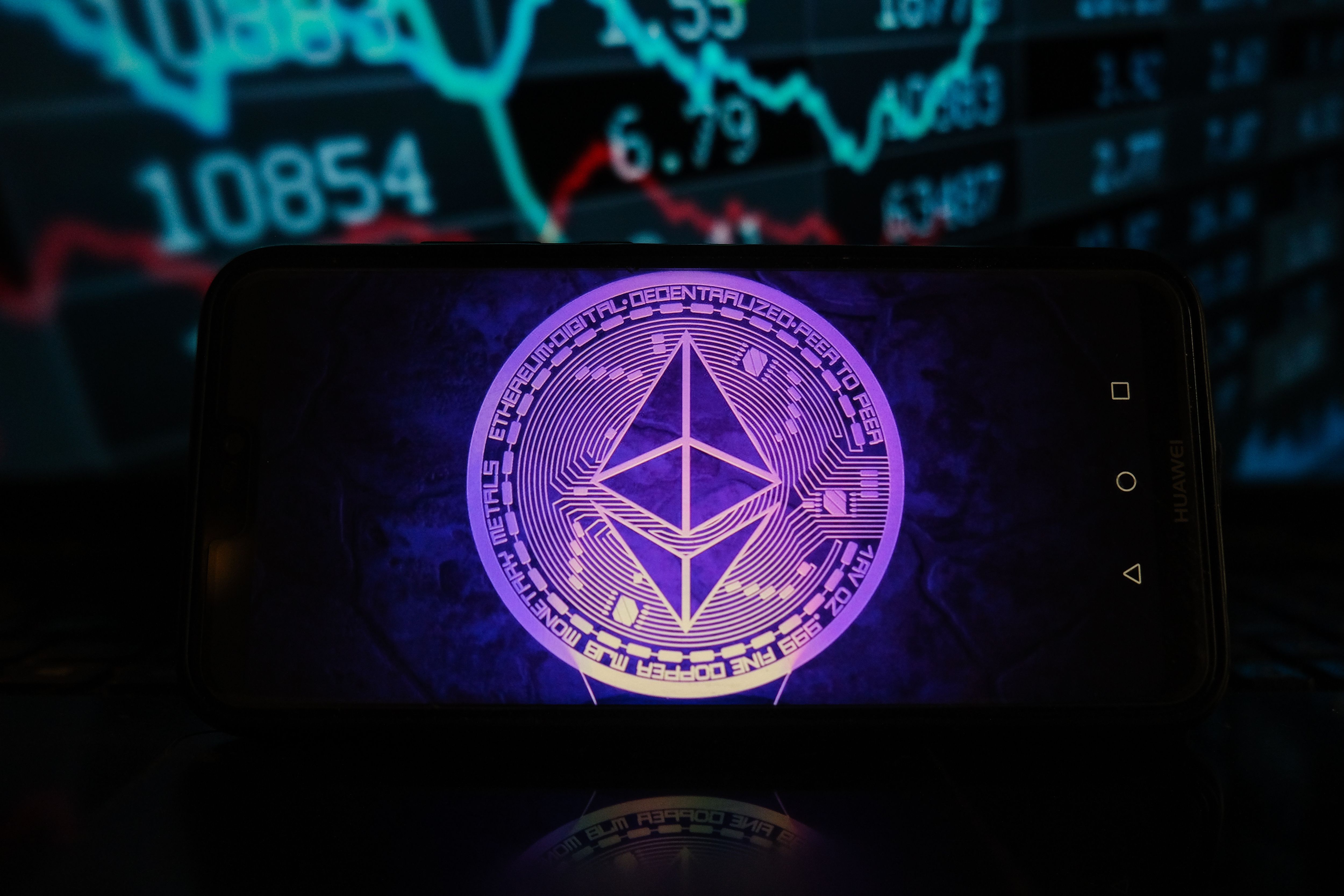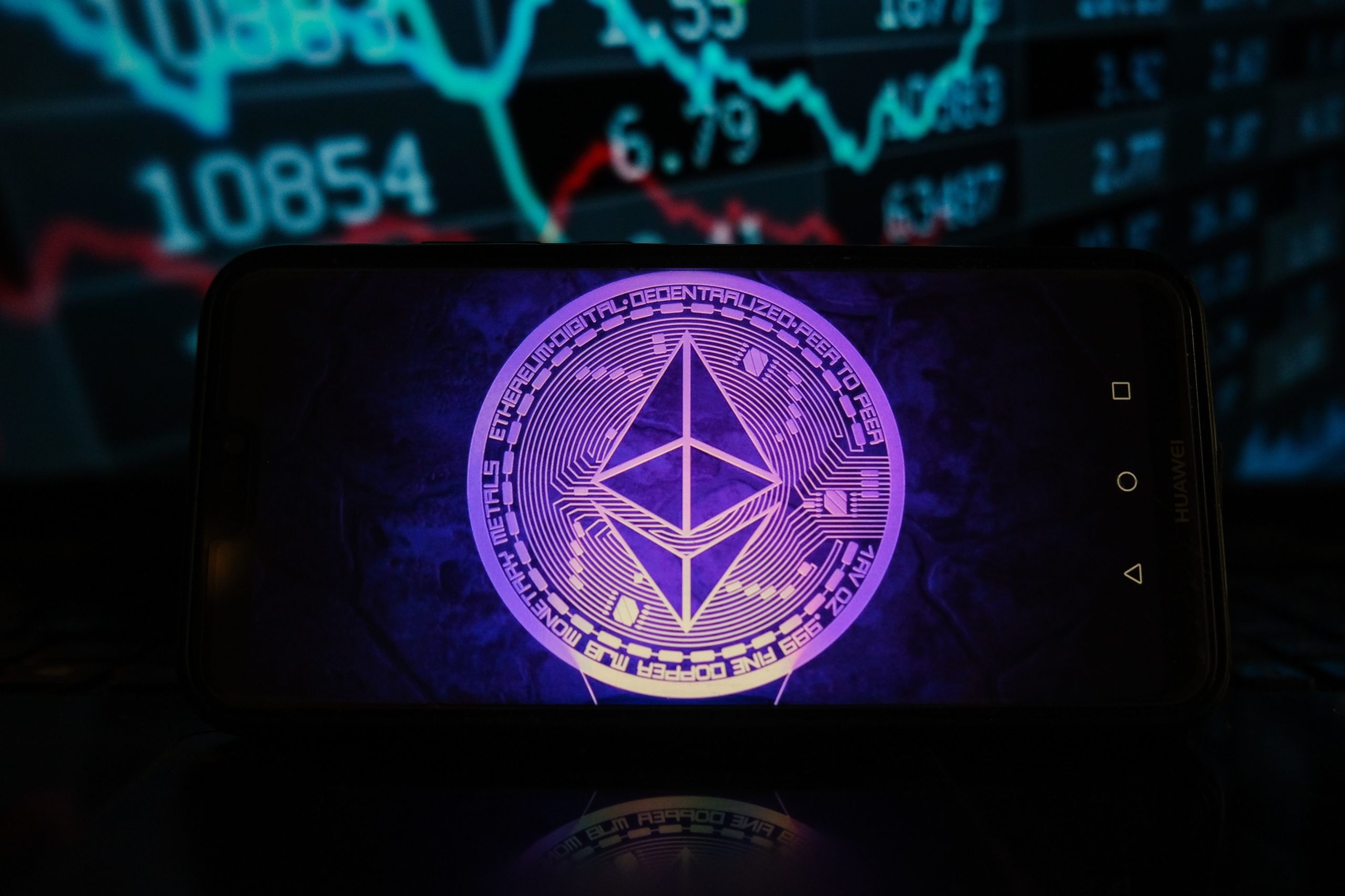
POLAND – 2021/03/21: In this photo illustration an Ethereum logo seen displayed on a smartphone with stock market percentages in the background. (Photo Illustration by Omar Marques/SOPA Images/LightRocket via Getty Images) Photo Illustration by Omar Marques/SOPA Images/LightRocket via Getty Images
The $69 million record sale of Beeple’s EVERYDAYS: THE FIRST 5000 DAYS by Christie’s in March 2021 fast-tracked the popularity of non-fungible tokens (NFTs) overnight. Many artists perceive this blockchain-based transaction as a quick and easy way to sell digital art through various platforms such as Foundation, OpenSea, and Rarible and oftentimes find themselves learning the hard way about gas fees, taxes, resale royalties, and copyright law. What should artists know (and do) before beginning an NFT endeavor? An attorney and artists’ rights advocate explains.
Understand NFTs
NFTs are blockchain-based records signifying the ownership of digital assets. Blockchain is a technology originally developed for Bitcoin and later adapted for use across industries (and other cryptocurrencies), which creates an immutable record of transactions by adding a new line of information each time the asset is transferred.Â
In the context of art, NFTs provide unique and clear proof of ownership and authorship by the artist, since the minting artist is always listed as the original owner of the digital artwork linked to the NFT. Minting is the process of authenticating an item on Ethereum’s blockchain by issuing a token, such as a digital record of the item. It is crucial to understand the relationship between the NFT platform, the artist, and the buyer: who owns what?Â
- The artist is the originator of the piece and owns the copyright in the work (provided that they actually made the work).
- The buyer receives a blockchain-based certificate of ownership, showcasing every previous owner.
- The NFT platform usually charges a service fee (akin to a commission), which the seller may build into the sales price.
While state sales tax is unlikely to apply to digital (i.e. intangible) assets, it is also important to know that the Internal Revenue Service (IRS) considers cryptocurrencies (such as Ether) to be “property†if the crypto asset acquired value over time and is used to purchase an NFT. This determination is akin to capital gains and creates a “taxable event†that should be recorded on tax returns.Â
Choose the best minting and selling platform for you and your work
The “do-it-yourself†process offered by NFT marketplaces permits artists to sell crypto-art without an art dealer or a gallery. With over 50 places for minting and trading NFTs, it is easy to get lost. Most minting platforms also double as marketplaces, but they are not all created equal and operate on different models. Some platforms are curated and invite-only (e.g. Nifty Gateway, Knoworigin, Foundation, SuperRare) and some require user verification before engaging in transactions (e.g. Rarible, Foundation). Most platforms charge a service fee: for example, Nifty Gateway takes 5% plus $0.30 of every secondary sale; SuperRare takes “a simple 3% transaction fee for all purchases, paid by the buyerâ€; and Foundation charges a 15% commission.Â
The computational mining engendered by transactions using Ethereum’s blockchain, which almost all of the NFT platforms use, requires the payment of “gas feesâ€. These fluctuate depending on network demand and essentially cover the energy required for the validation of that transaction on Ethereum. OpenSea, which also aggregates NFTs sold on other platforms, offers a “lazy minting†option, which amounts to the deferred payment of gas fees until the actual sale. If the cost of minting is too prohibitive, Mint Fund helps first-time crypto creators with covering the gas fee.
One benefit of selling digital art through blockchain technology, as opposed to more “traditional†art market transactions, is the automated resale royalties trickling back to the artist. Current U.S. law does not entitle artists to a percentage of the resale profits made by collectors on the secondary market. Aside from including a resale clause in a private contract (which itself may not even be enforceable), blockchain technology, by way of smart contracts, offers a welcome alternative. Smart contracts are a piece of self-executing code, a series of automated “if, then†conditions that allow for the distribution of funds, like resale royalties, to a named individual upon each transaction. Most NFT marketplaces build that automated resale into their smart contracts (e.g. SuperRare, Foundation) and may even offer the flexibility to choose the level of resale royalty (e.g. Nifty Gateway, Rarible). OpenSea allows developers to import their own smart contracts before minting an NFT or users can use the platform’s sample smart contract.
This added bonus is not without its limits: the automated resale royalty may only work when the NFT is resold through the same platform. For example, a work minted and sold on Nifty Gateway may not generate any income for the artist if it is offered for resale on Rarible; however, Foundation has an agreement with OpenSea that all secondary market sales on the latter will still distribute the 10% royalty. Similar to choosing an art dealer for the first sale of one’s artwork, this is an inherent risk of losing control over the piece (digital or not) once it changes hands.
Security: keep your information safe
Before minting an NFT on any platform, artists will need to connect a wallet containing Ether. Digital currencies may be stored in software wallets (through online exchange platforms such as Coinbase or MetaMask) or hardware wallets (an external hard drive). Hardware wallets are a longer-term investment that is proven to be more secure because they cannot be hacked when offline.
When choosing a crypto wallet, look for two-factor authentication, safely store your wallet address (similar to a debit card number) and your seed phrase (similar to a password), and get into the habit of using a VPN whenever trading cryptocurrencies. Artists should also check which wallet is accepted by the NFT marketplace (e.g. Foundation only uses MetaMask).Â
Be smart about copyright
Copyright is a bedrock of intellectual property and artists should know how and when to utilize it, especially when it comes to NFTs. The Copyright Act of 1976 grants authors of original pictorial, graphic, or sculptural works with the exclusive right to reproduce and distribute copies of the work, as well as the right to create derivative works.Â
In the U.S., while registering a copyright with the Copyright Office is not required for the associated rights to exist, it is necessary in order to enforce it against others. While platforms are required to have processes to report and to take down infringing materials, it is easy to take a few minutes to understand how to register a work of the visual arts, ideally before it gets published.
It is tempting to use preexisting images and to incorporate them into an NFT but doing so without a substantial transformation and clear added message means walking on a tightrope. Minting a digital artwork without express authorization by its author may result in litigation, and the infringer will have to argue that their use is “fair†under copyright law. In fair-use determinations, courts consider the similarity between the original and defendant’s work, the transformative nature and purpose of the defendant’s work, and the respective market in which the parties respectively evolve. By way of example, in the recent ruling of The Andy Warhol Foundation v. Goldsmith, a federal court of appeals sided with the photographer of Prince portraits which Andy Warhol used without her direct permission. A simple licensing agreement may avoid many headaches and is a great opportunity to collaborate with fellow creators.
Further, artists should be aware that the NFT purchaser does not get the right to reproduce the underlying work, absent an express written agreement between the artist and the buyer. However, through its Terms & Conditions, the NFT platform may give itself a non-exclusive, worldwide, assignable, sub-licensable, perpetual, and royalty-free license to reproduce and distribute copies of the work offered for sale through its services. Unfortunately, these terms are typically non-negotiable.
Make enlightened business decisions
Shifting one’s artistic practice to cryptoart must be carefully planned as a business decision similar to choosing an art dealer or a gallery. The cryptoart market is currently worth close to $445 million and Nifty Gateway is the current marketplace leader in sales volume. The competition is fierce, so it is important to understand the jargon, to pick the right platform, and to find knowledgeable experts to rely on for advice. Do not expect this to bring fast or steady income—it would be best not to earmark funds from the sale of cryptoart to pay rent. In this way, it is not that different from the “old†art market.
Additionally, think about the ecological impact of mining Ether: according to one researcher, the footprint used by computers to mint one single-edition NFT is equivalent to an EU resident’s total electric power consumption in one month. In comparison, over the course of 2020, the Louvre Museum in Paris had the same electricity consumption as 677,224 homes. You could consider investing some of the income earned from the sale of cryptoart to fund Jason Bailey’s GreenNFTs grant, or other efforts to reduce the energy consumption of NFTs.
Experiment with one piece at a time just as you would when starting with a new medium. You may want to create cryptoart that complements, incorporates, or rejuvenates pre-existing pieces by playing with media, such as turning paintings into interactive digital art by adding sound and playing with animations through .gif or .mp4 formats. You may also want to create an NFT-only series and see which works are most popular. Experiment and find what works best for you and your target collector, while also staying true to your brand, values, and community.Â
Ultimately, NFTs offer an attractive alternative to the traditional art market provided that one understands the legal ramifications. Choosing the right marketplace and artworks to offer for sale should be the result of careful consideration of practical, legal, and business aspects.

